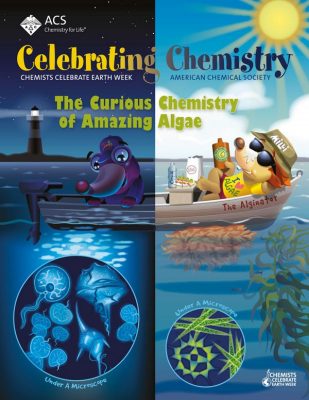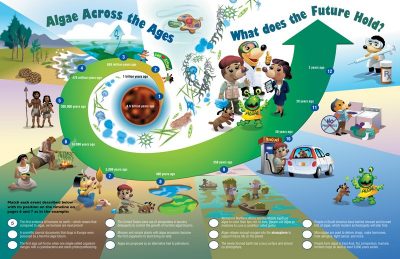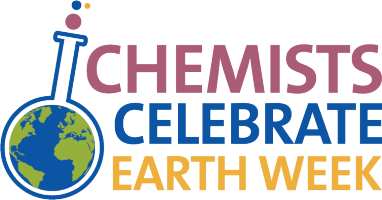CCEW 2023 Celebrating Chemistry
The Curious Chemistry of Amazing Algae

In this issue
Articles
What are Algae... and What is so Amazing about Them?
Algae are more than just green goo! Read more about their inside story and how are they are useful every day.
Algae are Elemental!
We couldn’t live without algae! Did you know they make more oxygen than plants?
Edible Algae
Look for which common foods contain algae. You might be surprised by some!
A Bright Glow from Tiny Creatures
We love things that glow in the dark … but have you seen the ocean glowing in the dark? Dive into this article for more information.
Meg A. Mole Interview with Dr. Eduardo J. Caro-Diaz
Meg A. Mole travels to San Juan, Puerto Rico to interview Dr. Eduardo J. Caro-Diaz, Assistant Professor at the School of Pharmacy, University of Puerto Rico!
Start Your Engines—with Algae!
Scientists are “engine”ering algae to make environmentally-friendly fuel not just for cars but even jets!
Activities
Science Safety Tips
Meg and Avi share important safety rules to follow every time you do a hands-on chemistry activity at home.
Transforming Gels
Do this activity and discover why some fruit-flavored gels are kept in the refrigerator while others are not.
Know by the Glow
Perform this activity to find out if algae have chlorophyll like plants do.
Algae Across the Ages: What Does the Future Hold?
Follow the journey in time from millions of years ago to the most recent advancements made with algae in the limelight … from algae lip color to algae car fuel to algae in fighting cancer!

Bonus Content
Bad Blooms: Algae Gone Wild!
From where do algae get their bad reputation? Keeping reading to know why.
Curb the Burp
We know of algae being used as health supplements. But this time, it is for cows!
Words to Know
Algae – a group of over 27,000 different aquatic organisms, most of which conduct photosynthesis. Most algae live in either fresh or saltwater, while some live on land in moist environments, such as in the fur of a sloth, in damp soil, or on tree trunks.
Algae (or harmful algal) bloom – an uncontrolled growth of algae caused by too many nutrients, which leaves the water with dangerously low levels of oxygen. This can cause animals such as fish and crustaceans to either move or die.
Aquatic organism – an alga, bacteria, plant, or animal that is part of a freshwater or saltwater ecosystem.
Atmosphere – the layer of gasses held around a planet by its gravity.
Biofuel – a renewable energy resource made from organisms, such as algae, plants, animals, or bacteria or their products. Biofuel can be used to power cars, trucks, and even jets.
Bioluminescence – light emitted by an organism through a chemical reaction between luciferin and oxygen.
Chlorophyll – a type of molecule that allows plants and algae to use sunlight to make their own food.
Ecosystem – an interconnected community of organisms and their physical environment.
Fluorescence – the light given off by an object or organism, at a lower energy than was taken in.
Food web – a network of organisms, including what they eat and what eats them.
Greenhouse gas – a compound in the atmosphere, such as water vapor, methane, or carbon dioxide, that lets sunlight warm the earth but prevents this heat from escaping our atmosphere into space.
Macroalgae – multi-celled red, brown, or green seaweed that range in size from just a few millimeters to more than 50 meters tall. Macroalgae form an important part of aquatic ecosystems.
Microalgae – tiny single-cell algae that are invisible to our eyes. They are found in saltwater or freshwater and are capable of photosynthesis. They live alone or as part of a colony with similar algae.
Photosynthesis – a series of chemical reactions conducted by algae and plants that use energy from the sun to convert water and carbon dioxide into glucose and oxygen.
Phytoplankton – a variety of photosynthetic microalgae that float near the surface of the water and serve as the base for the many aquatic food webs.
Acknowledgments
The articles and activities used in this publication were written by theme team members of the ACS Committee on Community Activities (CCA) under the leadership of Lori Stepan. Meg A. Mole’s interview was written by Kara KasaKaitas. The translation for Celebrando la Química was done by ACSI Translations.
Disclaimer
The activities described in this publication are intended for children under the direct supervision of adults. The American Chemical Society cannot be responsible for any accidents or injuries that may result from conducting the activities without proper supervision, from not specifically following directions, or from ignoring the cautions contained in the text.

CCEW 2023 Theme Team
- Rick Rogers, CCEW Chair
- Sara Delgado-Rivera, 2023 Co-Chair
- An-Phong Le, 2023 Co-Chair
- Cary Supalo
- Juan C. Aponte-Santini
- Regina M. Malczewski
- Robin Tanke
- Veronica Jaramillo
- Bill Doria
- Greglynn Gibbs
- Susan Hershberger
- Sherri Rukes
Production Team
- Sri Balasubramanian, Editor
- Eric Stewart, Copyeditor
- Jim Starr, Illustrator
- Michael Tinnesand, Copyeditor
- Rhonda Saunders, Designer
Technical and Safety Review Team
- Lynn Hogue, Consultant
- Bettyann Howson, Safety Reviewer
- Ashley Neybert, Accessibility Reviewer
- Sara Delgado-Rivera, Translation Reviewer
Division of Education
- Terri Chambers, Senior Director, Education Division
- Nancy Bakowski, Director of Academic Engagement and Outreach
- Lily L. Raines, Manager, Science Outreach
- Patti Galvan, Program Manager, Science Outreach
- Sri Balasubramanian, Program Specialist, Science Outreach

